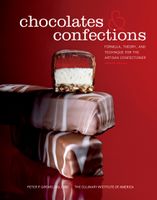Advertisement
Butter Ganache
Appears in
By Peter Greweling and Culinary Institute of America
Published 2007

Butter ganache is a confectionery center of European provenance that is not widely used in America. Introducing butter ganache centers into the confectioner’s product line can provide the savvy confectioner with flavors and textures that are not easily found elsewhere.
Butter ganache shares several traits with the more commonly used cream ganache: both may be used as either a pastry glaze or a confectionery center; the guideline for the ratio of chocolate to liquefiers is identical for each; and, like cream ganache, butter ganache is an emulsion. However, each of these similarities comes with a qualification: even when used as a glaze for pastries, butter ganache, unlike cream ganache, must be tempered in order to prevent the formation of bloom and to ensure a smooth texture; the ingredients considered liquefiers in butter ganache are different from those considered liquefiers in cream ganache; and the emulsion in butter ganache is a water-in-fat emulsion rather than a fat-in-water emulsion like cream ganache. Butter ganache may be used either by piping or slabbing; like cream ganache, there is a difference in makeup technique, depending on how the product is to be used. In addition, butter ganache always sets firmer than cream ganache due to its higher fat and lower water content. It is this lower water content—and accompanying lower water-activity level—that gives butter ganache a longer shelf life than cream ganache. An enrobed butter ganache center can be stored at room temperature for six to eight weeks. Butter ganache is quickly made up and crystallizes rapidly after depositing. It can usually be dipped in chocolate within thirty minutes of piping or slabbing. Because butter ganache sets up quickly, preparation is particularly important. Before beginning, be sure to have ready all depositing and portioning equipment, such as pastry bags, chocolate discs, frames, and spreading tools.

